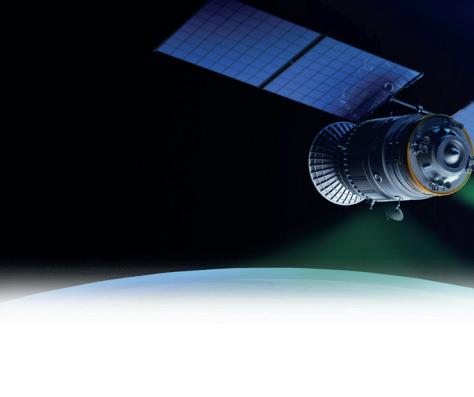
4 minute read
PROTECTED SATCOM
DOMINATING THE MODERN BATTLEFIELD
As armed forces demand optimal levels of connectivity across increasingly contested operating environments, L3Harris Technologies continues to extend its capability to provide protected Satellite Communications to customers around the world.
Advertisement
Customers worldwide are becoming increasingly concerned about the proliferation and emerging sophistication of threats across the Electromagnetic Spectrum and their potential effects on Satellite Communications (SATCOM) capabilities, according to L3Harris Technologies officials.
However, as Don Claussen, L3Harris’ vice president and general manager of Army, International and SATCOM programs, explained, protected SATCOM should be viewed as a “huge game changer” for armed forces seeking to overcome these challenges.
Protected SATCOM is a “key driver” in dominating the modern battlespace, according to Claussen.
“In order to do that, you have to communicate and know your adversary is going to try and deny communications,” he said. “So it’s critical that we have protected SATCOM and Line-Of-Sight communications.”
As electronic warfare threats continue, shielding communications from jamming and inclement weather is extremely important, he added. But, there’s a cost associated with this: the more an organization needs to spread its communications, more bandwidth is required.
“That’s why there has to be a two-pronged approach to protected SATCOM, reliant upon bespoke systems in addition to capacity being put up by commercial providers, especially in Ka-band,” he said.
Protected SATCOM can be ensured through the development of specialist waveforms as well as diversity in transmissions achieved through the deployment of highly customized satellite constellations and ground architectures.
As an example, L3Harris continues to support the U.S. Air Force’s Protected Tactical Enterprise Service, which includes the company’s Protected Tactical Waveform and Network Centric Waveform Resilient – both of which provide the end user with anti-jam capabilities. In April 2020, the U.S. Space Force’s Space and Missile Systems Center awarded L3Harris a $500 million contract to supply the Air Force and Army Anti-Jam Modem, which will provide warfighters with a secure, wideband and anti-jam SATCOM terminal to enable tactical communications in contested environments.
The deployment of the modems, which represents an important part of L3Harris’ growing Protected Anti-Jam Tactical Service Enterprise, allows armed forces to share critical mission data via resilient and secure SATCOM in the face of jamming by high-capability adversaries.
Considering how diverse ground architectures can also enable protected SATCOM, Claussen said L3Harris continues to explore multiple terminal concepts operating in Ka, Ku and X bands, capable of aggregating data so spacecraft can spread it across multiple hub nodes.
Claussen highlighted activities of commercial SATCOM providers including SpaceX, which continues to develop its Starlink Low Earth Orbit constellation to deliver low-latency and broadband internet to consumers anywhere in the world.
“Starlink has distributed ground stations similar to a cellular model, which are geographically dispersed providing it with some real resiliency there,” Claussen said. “An uplink jammer is not going to be able to cover all that ground.”
L3Harris is currently supporting a similar concept on behalf of the U.S. Army with SpaceX and SES. The Multi Orbit Satellite Service program is scheduled to be demonstrated to the Army in in October 2020. The goal is integrating commercial and bespoke protected SATCOM networks in Low Earth, Medium Earth and Geosynchronous orbits.
“Industry as a whole has to come together – we have all of these specific DOD programs that we are pursuing for protected SATCOM, but, at the same time, we sometimes need to partner to deliver the best solution,” Claussen said. “That’s our focus, and I think we are doing an extremely good job delivering it.”
Similar thoughts were shared by Loran Simper, vice president of Air Force and Classified Programs within L3Harris’ Broadband Communications Systems, who said the company continues to invest in Low Probability of Intercept/Detection waveforms that allow end users to communicate undetected in contested environments.
“Both L3 and Harris were working this capability in different avenues, so following the merger, we were able to take the best of breed from both companies to provide an optimal solution for our government customers,” he said.
Simper also identified the growing number of classified protected SATCOM programs emerging from the defense and security sector.
“This is a great growth area for L3Harris, and we are witnessing a tremendous uptick in satellite procurements, mainly in the classified area,” he added, noting work included developments in crosslink technology, protected waveforms and processing capabilities on-board spacecraft.
BROADBAND COMMUNICATIONS SOLUTIONS
L3Harris Technologies Broadband Communications capabilities provide secured mobile networked communications equipment and integration to meet a wide array of U.S. military mission requirements.
Air Force and Army Anti-Jam Modem (A3M):
A3M provides the Air Force and Army with a secure, wideband, anti-jam Satellite Communications terminal modem for tactical SATCOM operations. L3Harris modems are optimized for high-rate production and are designed to become an integral part of the service’s growing Protected Anti-Jam Tactical Service enterprise. Earlier this year, the U.S. Space Force Space and Missile Systems Center awarded L3Harris a five-year, $500 million ceiling IDIQ contract to use the modem for its branch’s operations.
Protected Tactical Waveform (PTW):
Several airborne and ground-based platforms and thousands of terminals across the U.S. Defense Department have been identified as transition candidates to the Protected Tactical Waveform.
A3M directly supports the U.S. Air Force’s Protected Tactical SATCOM and increases anti-jam and communications capacity for joint tactical warfighters in contested environments.
The Protected Tactical SATCOM program will implement PTW over a transponded satellite and a future fully processed satellite, enabling adaptive, anti-jam communications channels, which will provide some of the highest levels of protect for tactical U.S. and coalition/international partner warfighting efforts.









